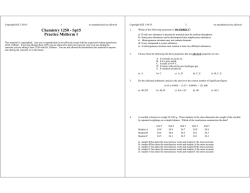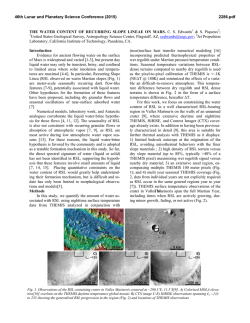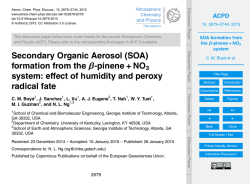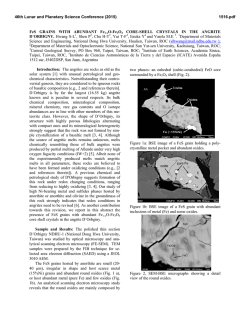
Supplement of Secondary Organic Aerosol (SOA) formation
Supplement of Atmos. Chem. Phys. Discuss., 15, 2679–2744, 2015 http://www.atmos-chem-phys-discuss.net/15/2679/2015/ doi:10.5194/acpd-15-2679-2015-supplement © Author(s) 2015. CC Attribution 3.0 License. Supplement of Secondary Organic Aerosol (SOA) formation from the β -pinene + NO3 system: effect of humidity and peroxy radical fate C. M. Boyd et al. Correspondence to: N. L. Ng ([email protected]) 1 Formaldehyde needed for dry “RO2+HO2 dominant” Experiments 2 Formaldehyde is added to the chamber in order to enhance the RO2+HO2 chemistry. Without 3 formaldehyde injection, simulation results based on the Master Chemical Mechanism (Equations 4 are given at the end of Supplement) show that RO2+RO2 would be the dominant fate. However, 5 once sufficient formaldehyde is added to the chamber experiments, we determine that the 6 RO2+HO2 pathway is substantially greater than the RO2+RO2 pathway. 7 8 To determine the concentration of formaldehyde needed to favor the RO2+HO2 channel 9 significantly over the RO2+RO2 channel, a comparison of relative reaction rates is required. 10 Specifically, in order to favor a branching ratio of RO2+HO2 to RO2+RO2 by 95% (19:1), it is 11 necessary that 12 13 𝑘𝑅𝑂2+𝐻𝑂2 [𝐻𝑂2 ][𝑅𝑂2 ] = 19𝑘𝑅𝑂2+𝑅𝑂2 [𝑅𝑂2 ][𝑅𝑂2 ] (SR1) 14 𝑘𝑅𝑂2+𝐻𝑂2 [𝐻𝑂2 ] = 19𝑘𝑅𝑂2+𝑅𝑂2 [𝑅𝑂2 ] (SR2) 15 𝑘𝑅𝑂2+𝐻𝑂2 𝑑[𝐻𝑂2 ] 𝑑𝑡 = 19𝑘𝑅𝑂2 +𝑅𝑂2 𝑑[𝑅𝑂2 ] 𝑑𝑡 (SR3) 16 17 Rates of production for each radical can then be used as a surrogate for the approximate 18 concentrations as the radicals are expected to be consumed immediately upon production. The 19 rates of production are: 20 21 22 𝑑[𝐻𝑂2 ] 𝑑𝑡 𝑑[𝑅𝑂2 ] 𝑑𝑡 = 𝑘𝐻𝐶𝐻𝑂+𝑁𝑂3 [𝐻𝐶𝐻𝑂][𝑁𝑂3 ] (SR4) = 𝑘𝛽𝑝𝑖𝑛+𝑁𝑂3 [𝛽𝑝𝑖𝑛][𝑁𝑂3 ] (SR5) 23 24 Thus equation SR3 becomes: 25 26 𝑘𝑅𝑂2+𝐻𝑂2 𝑘𝐻𝐶𝐻𝑂+𝑁𝑂3 [𝐻𝐶𝐻𝑂][𝑁𝑂3 ] = 27 19𝑘𝑅𝑂2 +𝑅𝑂2 𝑘𝛽𝑝𝑖𝑛+𝑁𝑂3 [𝛽𝑝𝑖𝑛][𝑁𝑂3 ] (SR6) 28 29 𝑘𝑅𝑂2+𝐻𝑂2 𝑘𝐻𝐶𝐻𝑂+𝑁𝑂3 [𝐻𝐶𝐻𝑂] = 19𝑘𝑅𝑂2 +𝑅𝑂2 𝑘𝛽𝑝𝑖𝑛+𝑁𝑂3 [𝛽𝑝𝑖𝑛] (SR7) 1 30 Therefore, the ratio of formaldehyde to β-pinene should be (kRO2+RO2 = 9.2E-14 cm3 molecules-1 31 s-1; kβpin+NO3 = 2.5E-12 cm3 molecules-1 s-1; kRO2+HO2 = 9.2E-14 cm3 molecules-1 s-1; kHCHO+NO3 = 32 5.5E-16 cm3 molecules-1 s-1, all rate constants are from MCM v3.2 (Saunders et al., 2003)): 33 [𝐻𝐶𝐻𝑂] 34 [𝛽𝑝𝑖𝑛] = 19𝑘𝑅𝑂2 +𝑅𝑂2 𝑘𝛽𝑝𝑖𝑛+𝑁𝑂3 𝑘𝑅𝑂2 +𝐻𝑂2 𝑘𝐻𝐶𝐻𝑂+𝑁𝑂3 = 350 (SR8) 35 36 Results from Filter Sample Analysis 37 The UHPLC-MS total ion chromatogram for a typical “RO2+NO3 dominant” experiment under 38 dry conditions is displayed in Fig. S4, which also represents the features observed in all other 39 experiments under dry and humid conditions. Excluding the solvent peak at ~0.2 min and 40 discarding the presence of any relevant species in the controls, the chromatogram in Fig. S4 41 reveals peaks with retention times of 3.26, 3.28, 6.19, 6.27, 7.03, and 7.08 min. These peaks are 42 displayed in the extracted ion chromatograms (EIC) for species with m/z 489, 244, 473, 489, 505 43 and 522. 44 45 The collisional induced dissociation (CID) of the peak at ~3.26 min is displayed in Fig. S5 for 46 the interval 30-70 V. Clearly, two anions with m/z 244 and 489 are observed at 3.26 min under 47 low fragmentation voltage (30 and 40 V). The prominent peak m/z 290 is mainly due the 48 presence of an adduct of the parent peak with formic acid: [M-H] + HCOOH = 244 + 46 = 290. 49 Support for the previous observation is also based on the appearance of the adduct [M-H] + 50 CH3COOH = 244 + 60 = 304 in the presence of acetic acid, instead of formic acid, in the mobile 51 phase. The ion observed at m/z 197 becomes more intense at higher fragmentation voltage before 52 starting to break apart above 60 V. The parent peak m/z 244 must undergo the concerted loss of 53 nitrous acid, HNO2, to produce m/z 197. The loss of HNO2 explains the change from an even to 54 an odd mass, which may be facilitated by intramolecular hydrogen transfer from the hydroxyl 55 group to the leaving -NO2 moiety, leaving a carboxylate group as a rearranged fragment. The 56 confirmation of the presence of a –COOH group in the neutral molecule with molecular mass 57 245 amu arises from the decarboxylative loss of 44 amu from the fragment ion m/z 197 that 58 generates a new fragment at m/z 153. 59 2 60 The MS peak at m/z 489 in Fig. S5 does not show the formation of either a formic acid or an 61 acetic acid adduct. In addition, the lack of a constant ratio for the ion count of species at m/z 244 62 and 489 in all experiments suggests that different formation pathways result in both products. 63 The careful analysis of the data presented showing the formation of formate or acetate adducts 64 for the species at m/z 244, and its excellent ionization at very low fragmentation voltage suggest 65 that the co-eluting species at m/z 489 should be a carboxylic acid molecule in the mechanistic 66 scheme (Fig. S6) to be presented below. 67 68 The chromatographic peak eluting at 6.19 min in Fig. S4 displayed as an EIC for m/z 505 with 69 broad features corresponds to a species with molecular weight (MW) of 506 amu. Given the 70 nitrogen rule, this species with even MW must contain an even number of nitrogen atoms. The 71 combination of two β-pinene molecules, which have incorporated nitrate radicals, provides a 72 starting mass of 396 amu for this species. The mass difference (506 – 396) amu = 110 amu 73 eliminates the possibility of including a third -pinene molecule or two more nitrate radicals in 74 this product. Therefore, a general formula of C20H30N2O13 is assigned to this species. The ring 75 and double bond equivalency (RDB) defines the number of unsaturated bonds in the compound: 76 𝑖 77 𝑅𝐷𝐵 = 1 + ∑𝑖𝑚𝑎𝑥 𝑁𝑖 (𝑉𝑖 −2) 2 (SR17) 78 79 where imax is the total number of different elements in the molecular formula, Ni is the number of 80 atoms of element i, and Vi is the valence of atom I (Pavia et al., 2008). For C20H30N2O13, RDB = 81 7 from limiting the calculated formulas that make sense chemically, a -C=O group should be 82 included in the structures of the mechanism forming species with this MW. Similarly, the EIC 83 for m/z 522 shows a broad peak that could correspond to a less polar isomer species eluting at 84 6.27 min. A molecular structure with two β-pinene units and an odd number of nitrogen atoms is 85 assigned to be C20H33N3O13 (MW = 523 amu) with RDB = 6 in the mechanism presented below. 86 87 Remarkably, a second species with m/z 489 elutes at 7.09 min in the EIC of Fig. S4, which 88 possesses a carbonyl group absorbing with λmax = 275 nm in the UV-visible spectrum. This 89 molecule elutes later in the chromatogram, in the region of species with lower polarity –without 90 a -COOH group– because it corresponds to a less polar structural isomer than that eluting at 3.26 3 91 min. The most likely general formula for this species is C20H30N2O12 (MW = 490) with RDB = 7, 92 shown as the non-carboxylic acid structure in the mechanism introduced in the next section. A 93 slightly lighter species with m/z 473 (MW = 474 amu) and retention time of 7.03 min also 94 contains a carbonyl group in the UV-visible spectrum. The even molecular weight of this 95 molecule indicates a species with an even number of nitrogen atoms. The similar retention times 96 between both species (m/z 474 and 490) and the mass difference of only 16 amu suggests a 97 common molecular structure that differs by one oxygen atom. The molecular formula 98 C20H33N2O11 (MW = 474 amu) is represented by the proposed structures displayed in Fig. S6. 99 100 Figure S6 shows the further oxidation of some of the products shown in Fig. 8 of the main text. 101 Panel A of Fig. S6 shows the hydroxycarbonyl nitrate product with MW = 229 amu can be 102 further oxidized to the peroxy radical V by hydrogen abstraction from C4 (R27) and subsequent 103 reaction with oxygen (R28). Hydrogen abstraction from the dihydroxycarbonyl nitrate generated 104 from V by R29 occurs preferentially on a –CH3 group (C9 or C10) by R30, proceeding through an 105 alkyl radical with true trigonal pyramidal geometry, an unfavorable intermediate for C5, C7, and 106 C8 due to the geometric constrains imposed by the cyclobutane ring (Vereecken and Peeters, 107 2012). Less likely is the abstraction occurring at C4, due to both the hindrance created by the 108 alcohol substituent and the slight strain from the adjacent butane ring. Addition of O2 is also 109 included in R30 (Atkinson and Arey, 2003), resulting in a peroxy radical W. Reaction R31 for 110 W + L˙ produces an alcohol (R31OH) which can undergo a second H-abstraction by step 1 of 111 R32 at the same carbon, C10. C10 is slightly more electropositive than C9 due to the hydroxyl 112 substituent, and abstraction of the only H remaining at the more hindered C4 of W is less likely 113 to occur than at C10. Step 2 of R32 shows the formation of a peroxy radical Y through 114 combination with molecular oxygen (Atkinson and Arey, 2003). Panel B shows the oxidation of 115 the hydroxynitrate acid product, R20COOH, through hydrogen abstraction and reaction with 116 molecular oxygen in R33 to peroxy radical X. Panel C shows in reaction R34 how a second 117 nitrate radical can add to the newly generated double bond of the hydroxynitrate product of R7 118 (Fig. 8, main text). The nitrate radical adds to the less substituted C7, leaving a relatively stable 119 tertiary alkyl radical on C2, which combines with O2 via reaction R35 to form a peroxy radical Z. 120 4 121 Figure S7 shows how intermediates presented in Fig. 8 of the main text, S, T, and U combine 122 with radicals V, W, X, Y, Z presented in Fig. S6 to produce the heavier MW products observed 123 in aerosol filter extracts by UHPLC-MS via RO2+RO2 reactions. It is noted that each product in 124 Fig. S7 may be formed from the combination of other intermediates not explicitly drawn in Fig. 125 8 in the main text and Fig. S6. These findings are in agreement with previous work showing the 126 formation of organic peroxides during the oxidation of terpenes (Ng et al., 2008; Venkatachari 127 and Hopke, 2008; Docherty et al., 2005). Figure S7 shows that the major heavy MW species in 128 the UHPLC chromatogram of Fig. S4 can be generated from the same early oxidation 129 intermediates S, T, and U, implying the possible existence of more than one isomer for each 130 mass. The later observation is consistent with the EIC in Fig. S4 showing broad peaks in the 131 UHPLC-MS for m/z 505, 522, and the later 489, and a clear shoulder for m/z 473. 132 133 Model Calculations for “RO2+NO3 dominant” Experiments 134 To ensure that the reaction conditions are favorable for the RO2+NO3 reaction, a simple chemical 135 model is developed using the Master Chemical Mechanism (MCM v3.2) as a basis (Saunders et 136 al., 2003). Reactions and their rate constants are shown in Table S1. The RO2 fate in a typical 137 “RO2+NO3 dominant” experiment (Experiment 5 in Table 1 of the main text) is shown in Fig. 138 S9. 139 140 141 142 143 144 145 146 147 148 149 150 151 5 152 References 153 154 155 156 157 158 159 160 161 162 163 164 165 166 167 168 169 170 171 172 173 174 175 176 177 178 179 180 181 182 183 184 185 186 187 188 189 190 191 Atkinson, R., and Arey, J.: Gas-phase Tropospheric Chemistry of Biogenic Volatile Organic Compounds: A Review, Atmos. Environ., 37, 197-219, 2003. Docherty, K. S., Wu, W., Lim, Y. B., and Ziemann, P. J.: Contributions of Organic Peroxides to Secondary Aerosol Formed from Reactions of Monoterpenes with O3, Environ. Sci. Technol., 39, 4049-4059, 2005. Neuman, J. A., Nowak, J. B., Huey, L. G., Burkholder, J. B., Dibb, J. E., Holloway, J. S., Liao, J., Peischl, J., Roberts, J. M., Ryerson, T. B., Scheuer, E., Stark, H., Stickel, R. E., Tanner, D. J., and Weinheimer, A.: Bromine measurements in ozone depleted air over the Arctic Ocean, Atmos. Chem. Phys., 10, 6503-6514, 10.5194/acp-10-6503-2010, 2010. Ng, N. L., Kwan, A. J., Surratt, J. D., Chan, A. W. H., Chhabra, P. S., Sorooshian, A., Pye, H. O. T., Crounse, J. D., Wennberg, P. O., and Flagan, R. C.: Secondary Organic Aerosol (SOA) Formation from Reaction of Isoprene with Nitrate Radicals (NO3), Atmos. Chem. Phys., 8, 41174140, 2008. Odum, J. R., Hoffmann, T., Bowman, F., Collins, D., Flagan, R. C., and Seinfeld, J. H.: Gas/Particle Partitioning and Secondary Organic Aerosol Yields, Environ. Sci. Technol., 30, 2580-2585, 10.1021/es850943+, 1996. Pavia, D., Lampman, G., Kriz, G., and Vyvyan, J.: Introduction to spectroscopy, Cengage Learning, 2008. Sander, S. P., Abbatt, J., Barker, J. R., Burkholder, J. B., Friedl, R. R., Golden, D. M., Huie, R. E., Kolb, C. E., Kurylo, M. J., Moortgat, G. K., Orkin, V. L., andWine, P. H.: Chemical kinetics and photochemical data for use in atmospheric studies: Evaluation Number 17, Jet Propulsion Laboratory, 2011. Saunders, S. M., Jenkin, M. E., Derwent, R. G., and Pilling, M. J.: Protocol for the development of the Master Chemical Mechanism, MCM v3 (Part A): tropospheric degradation of nonaromatic volatile organic compounds, Atmos. Chem. Phys., 3, 161-180, 2003. Venkatachari, P., and Hopke, P. K.: Characterization of Products formed in the Reaction of Ozone with α-pinene: Case for Organic Peroxides, J. Environ. Monitor., 10, 966-974, 2008. Vereecken, L., and Peeters, J.: A Theoretical Study of the OH-initiated Gas-phase Oxidation Mechanism of b-pinene (C10H16): First Generation Products, Phys. Chem. Chem. Phys., 14, 3802-3815, 10.1039/C2CP23711C, 2012. 192 193 6 194 Table S1: List of reactions and their rate constants for the β-pinene+NO3 system. Reactions are 195 adapted from MCMv3.2 (Saunders et al., 2003)a. Reaction: Rate Constant: NO2 + O3 → NO3 + O2 3.2∙10-17 cc molecules-1 s-1 b NO2 + NO3 → N2O5 6.7∙10-12 cc molecules-1 s-1 b N2O5 → NO2 + NO3 2.2∙10-1 s-1 b OH + O3 → HO2 + O2 7.3∙10-14 cc molecules-1 s-1 b OH + HO2 → H2O2 + O2 1.1∙10-10 cc molecules-1 s-1 b HO2 + O3 → OH + 2O2 1.9∙10-15 cc molecules-1 s-1 b HO2 + HO2 → H2O2 + O2 1.4∙10-12 cc molecules-1 s-1 b NO + HO2 → NO2 + OH 8.1∙10-12 cc molecules-1 s-1 b NO + O3 → O2 + NO2 1.9∙10-14 cc molecules-1 s-1 b NO + NO3 → 2 NO2 2.6∙10-11 cc molecules-1 s-1 b HCHO + NO3 → HNO3 + CO + HO2 5.5∙10-16 cc molecules-1 s-1 β-pinene + NO3 + O2 → NBPINAO2 0.8∙2.51∙10-12 cc molecules-1 s-1 β-pinene + NO3 + O2 → NBPINBO2 0.2∙2.51∙10-17 cc molecules-1 s-1 β-pinene + O3 + O2 → NOPINONE + CH200F 0.4∙1.5∙10-17 cc molecules-1 s-1 β-pinene + O3 + O2 → NOPINOOA + HCHO 0.6∙1.5∙10-17 cc molecules-1 s-1 NBPINAO2 + HO2 → NBPINAOOH 2.09∙10-11 cc molecules-1 s-1 NBPINAO2 + NO → NBPINAO 9.04∙10-12 cc molecules-1 s-1 NBPINAO2 + NO3 → NBPINAO 2.3∙10-12 cc molecules-1 s-1 NBPINAO2 + RO2 → NBPINAO 0.7∙9.2∙10-14 cc molecules-1 s-1 NBPINAO → NOPINONE + HCHO + NO2 106 s-1 NBPINAO2 + RO2 → BPINBNO3 0.3∙9.2∙10-14 cc molecules-1 s-1 NBPINBO2 + HO2 → NBPINBOOH 2.09∙10-11 cc molecules-1 s-1 NBPINBO2 + NO → NBPINBO 9.04∙10-12 cc molecules-1 s-1 NBPINBO2 + NO3 → NBPINBO 2.3∙10-12 cc molecules-1 s-1 NBPINBO2 + RO2 → NBPINBO 0.6∙2∙10-12 cc molecules-1 s-1 NBPINAO → NOPINONE + HCHO + NO2 7∙103 s-1 NBPINAO2 + RO2 → BPINANO3 0.2∙2∙10-12 cc molecules-1 s-1 7 NBPINAO2 + RO2 → NC91CHO 0.6∙2∙10-12 cc molecules-1 s-1 NC91CHO + NO3 → NC91CO3 2.32∙10-14 cc molecules-1 s-1 NC91CO3 + HO2 → NC91CO3H 0.56∙1.39∙10-11 cc molecules-1 s-1 NC91CO3 + HO2 → NOPINONE + NO3 + OH + HCHO 0.44∙1.39∙10-11 cc molecules-1 s-1 NC91CO3 + NO → NOPINONE + HCHO + 2NO2 1.98∙10-11 cc molecules-1 s-1 NC91CO3 + NO2 → NC91PAN 9.4∙10-12 cc molecules-1 s-1 NC91PAN →NC91CO3 + NO2 3.0∙10-4 s-1 NC91CO3 + NO3 → NOPINONE + HCHO + 2NO2 4.0∙10-12 cc molecules-1 s-1 NC91CO3 + RO2 → NOPINONE+ HCHO + NO2 10-11 cc molecules-1 s-1 CH2OOFA → CH2OO 0.37∙106 s-1 CH2OOFA → CO 0.5∙106 s-1 CH2OOFA → HO2 + CO + OH 0.13∙106 s-1 CH2OO + CO → HCHO 1.2∙10-15 cc molecules-1 s-1 CH2OO + NO → HCHO 1.0∙10-14 cc molecules-1 s-1 CH2OO + NO2→ HCHO 1.0∙10-15 cc molecules-1 s-1 CH2OO + H2O→ HCHO 6.0∙10-18 cc molecules-1 s-1 CH2OO + H2O→HCOOH 1.0∙10-17 cc molecules-1 s-1 196 a 197 b Unless otherwise noted, all reaction rates are from MCM v. 3.2 Reaction rates are from Sander et al. (2011) and the references therein 198 199 200 201 202 203 204 205 206 207 208 209 8 8000 - C10H17NO5• I (MW = 231) 6000 - Signal (Hz) C10H15NO5• I (MW = 229) 4000 - C10H17NO4• I (MW = 215) - C10H15NO6• I (MW = 245) 2000 0 330 340 350 360 370 380 Mass (amu) 210 211 212 Figure S1: Chemical Ionization Mass Spectrometry (CIMS) spectra for a typical “RO2+HO2 213 dominant” experiment under dry conditions showing the major gas-phase compounds from the β- 214 pinene+NO3 reaction. The measured species are proposed to be organic nitrates due to their odd 215 molecular weights. The specific molecular formulas for the ions shown are inferred from the 216 chemical mechanism (Fig. 8, main text). 217 218 219 220 221 222 223 9 800 RH < 2% "RO2+NO3 Dominant" (NH4)2SO4 RH < 2% "RO2+HO2 Dominant" (NH4)2SO4 RH = 50% "RO2+NO3 Dominant" (NH4)2SO4 RH = 50% "RO2+HO2 Dominant" (NH4)2SO4+H2SO4 m/z 358 Normalized to Br2 600 400 200 0 0 224 50 100 150 200 Time (min) 250 300 350 225 226 Figure S2: CIMS time series for m/z 358 for the β-pinene+NO3 reaction at all conditions. m/z 227 358 corresponds to a molecule-iodide adduct where the molecule has a molecular weight of 231 228 amu. The signal is normalized to the instrument sensitivity to Br2 to account for any sensitivity 229 changes in the CIMS (Neuman et al., 2010). The species at m/z 358 is proposed to be either from 230 a hydroperoxide (ROOH) or a dihydroxynitrate. It is significantly higher in experiments where 231 RO2+HO2 is the dominant reaction pathway. Gaps in the data are from periodic measurements of 232 the CIMS background. It is noted that the data shown above have not been corrected for CIMS 233 background. 234 10 120 Aerosol Mass Yield (%) 100 80 60 40 RO2+NO3 Yield Curve RH = 50%, (NH4)2SO4+H2SO4 Seed, "RO2+NO3 Dominant" 20 0 0 20 40 60 80 100 120 140 160 180 200 220 3 235 Organic Mass Loading (g/m ) 236 237 Figure S3: The yields for the experiments using (NH4)2SO4+H2SO4 seed (circles) reported 238 alongside the yields for the experiments using (NH4)2SO4 seed (red curve) in “RO2+NO3 239 dominant” experiments. As seen in this figure, results from the experiments with 240 (NH4)2SO4+H2SO4 seed are in agreement with the yield curve generated by the two-product 241 model (Odum et al., 1996) for experiments conducted in the presence of (NH4)2SO4 seed. 242 243 244 245 246 247 11 m/z 522 (x 5) m/z 489 Extracted ion count m/z 489 2 x 104 m/z 505 m/z 473 Ion count/105 m/z 244 (x 5) 12 m/z 244 6 4 2 0 248 2 4 6 8 10 Retention time (min) 249 250 Figure S4: Total (bottom panel and left axis) and extracted (top panel and right axis) ion 251 chromatogram (EIC) for eluting peaks at m/z 244, 489, 505, 522, and 473, and 489 in the 252 UHPLC-MS chromatogram of a “RO2+NO3 dominant” experiment under dry conditions, in the 253 presence of 0.1 mM HCOOH (fragmentor voltage = 50 v). The box shows the EIC for m/z 244 254 using 0.4 mM CH3COOH instead of HCOOH (fragmentor voltage = 30 v). 255 256 257 258 259 260 261 262 263 264 265 266 267 268 269 270 12 271 272 Figure S5: Collisional induced dissociation mass spectra of chromatographic peak in Fig. S4 at 273 3.27 0.03 min between 30 and 70 V. 274 275 276 277 278 279 280 281 282 283 284 285 286 287 13 288 289 290 Figure S6: Proposed pathways for the further oxidation of products proposed in Fig. 8 of the 291 main text. Named radicals are proposed to react to form the higher molecular weight species in 292 Fig. S7. 293 294 14 295 296 297 Figure S7: Proposed pathways for the production of organic peroxides from radicals S, T, and U 298 (Fig. 8, main text) by reaction with radicals V, W, X, Y, and Z (Fig. S6, Supplement). 299 300 301 302 303 304 15 120 Aerosol Mass Yield (%) 100 80 60 RO2+NO3 Yield Curve RH < 2%, Nucleation, "RO2+NO3 Dominant" RH = 50%, Nucleation, "RO2+NO3 Dominant" RH < 2%, Nucleation, "RO2+HO2 Dominant" RH =70%, Nucleation, "RO2+HO2 Dominant" 40 20 0 0 20 40 60 80 100 120 140 160 180 200 220 3 305 Organic Mass Loading (g/m ) 306 Figure S8: The yields for nucleation experiments for all conditions are reported alongside the 307 yields for experiments with (NH4)2SO4 seed. The yields from the nucleation and seeded 308 experiments in the “RO2+NO3 dominant” experiments are in agreement with each other while 309 the “RO2+HO2 dominant” experiments are significantly lower than under seeded conditions. The 310 y-axis error bars represent uncertainty in yield calculated by an 8% uncertainty in chamber 311 volume, 5% uncertainty in hydrocarbon injection, and one standard deviation of the aerosol 312 volume measured by SMPS at peak growth. 313 314 315 316 317 318 319 16 320 0.7 Cumulative RO2 Branching Ratio 0.6 RO2+HO2 RO2+NO3 RO2+RO2 0.5 0.4 0.3 0.2 0.1 0.0 0 5 321 10 Time (minutes) 15 20 322 323 Figure S9: The RO2 branching ratio for a typical “RO2+NO3” dominant experiment (Experiment 324 5 in Table 1 of the main text). The branching ratio is determined from the reactions in the Master 325 Chemical Mechanism (MCM v 3.2). The plot shows the cumulative amount of products formed 326 from each possible fate of RO2 radicals. 327 17
© Copyright 2025








